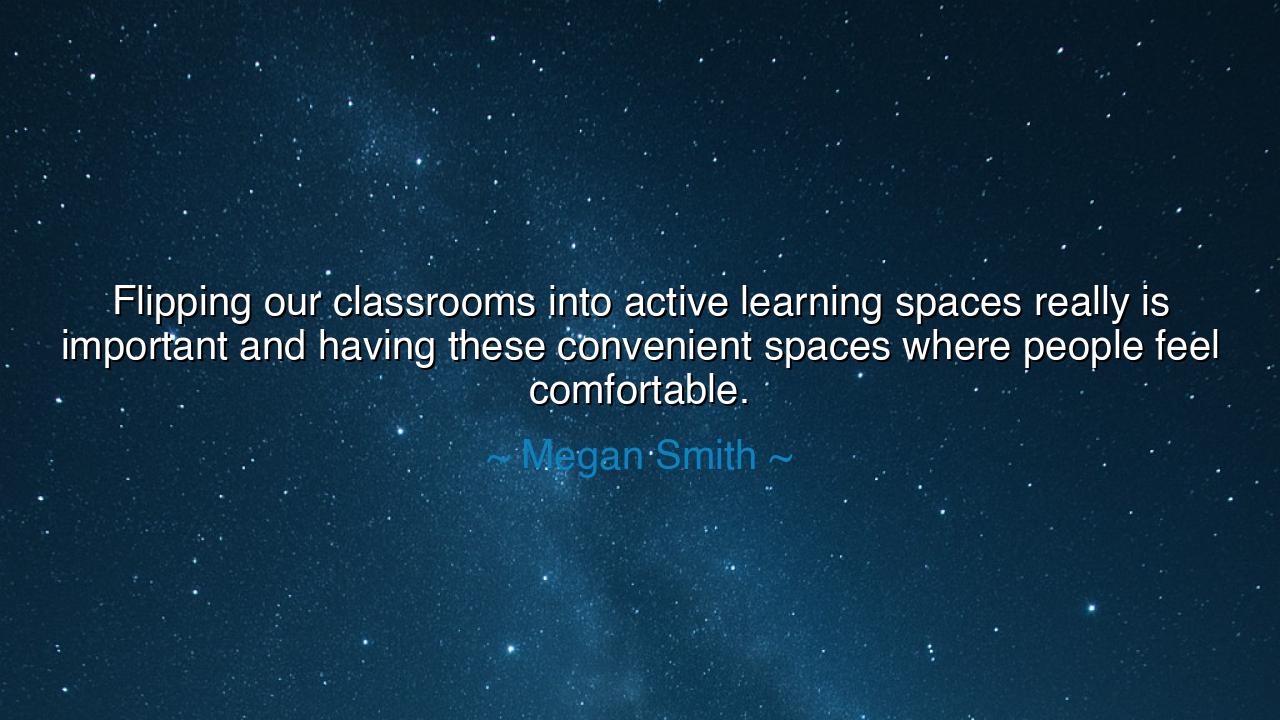
Flipping our classrooms into active learning spaces really is
Flipping our classrooms into active learning spaces really is important and having these convenient spaces where people feel comfortable.






In the tongue of the elders, we say: the mind is not a jar to be filled, but a fire to be kindled. Thus Megan Smith’s counsel rings true: “Flipping our classrooms into active learning spaces really is important, and having these convenient spaces where people feel comfortable.” Here the sentence is a bridge from old wisdom to new rooms. It calls us to overturn the tables of passive listening and set out the tools of craft—questions, sketches, arguments, experiments—so that learning becomes motion, not merely memory.
To flip a room is to reverse the flow of power: the teacher’s voice becomes a compass, not a monologue; the student’s hands become instruments, not ornaments. Active learning is the ancient rhythm of apprentices at the forge—watch, try, err, refine—translated for the age of whiteboards and wireless. But the forge must be fitted to the worker: circular chairs that invite faces to meet; margins for moving; light enough for eyes, quiet enough for thought. Spaces matter because bodies matter; and when the body feels comfortable, the mind ventures farther.
Consider the tale of a physicist troubled by his own success. Eric Mazur taught brilliant lectures in a grand hall, yet his students stumbled on the simplest conceptual questions. He turned, then, from pronouncement to active learning—peer instruction, short pulses of explanation, questions that made the room argue with itself. The hall, once a theater, became a workshop; comprehension rose because courage rose. The classroom changed not by adding more words, but by changing the space where words became work.
Or look farther back to Maria Montessori, who prepared environments where children could choose meaningful tasks with their own hands. Low shelves, real tools, materials that beckoned to be touched—the room itself taught. The teacher watched like a gardener, pruning and guiding, but never smothering the sun. In these convenient and comfortable settings, attention lengthened, confidence thickened, and discipline became joy. The room was not an accident of architecture; it was a pedagogy made visible.
This is the heart of Smith’s saying: architecture is argument. A lecture hall with bolted seats argues that listening is learning; a room with movable tables argues that thinking is collaboration. A corridor of glass argues that thought should be seen; a corner with cushions argues that silence has a place. When we flip the classroom, we also flip our expectations—students move from audience to authors, from recipients to researchers, from “What will be on the test?” to “What question is worth a test?”
Let us speak plainly to the keepers of schools: if a lesson can be watched at home, spare the school day for what cannot—struggle shared, feedback immediate, experiments unsafe to run alone, stories that need a circle to be heard. Give your hours to the parts of learning that require a human room. Make the space a covenant: all voices welcome, all questions allowed, all errors treated as ore to be smelted, not stains to be hidden. In such rooms, the shy step forward, the confident learn to listen, and knowledge grows legs.
Take this as a rule for practice: (1) Begin each unit with a problem that pinches—let active learning start in necessity. (2) Arrange the classroom so every chair can turn to face another; mobility is pedagogy. (3) Put core content on short, clear pre-work; spend class on making, debating, and doing. (4) Build convenient rituals—entry questions, think-pair-share, quick writes—that lower the cost of starting. (5) Tend the climate: warm light, visible norms, invitations posted on the wall—so all feel comfortable taking intellectual risks. (6) End with reflection that names what changed in the mind, not only what was covered on the board. Walk this path, and your room will cease to be a storage bin for bodies and become a workshop for souls.






AAdministratorAdministrator
Welcome, honored guests. Please leave a comment, we will respond soon